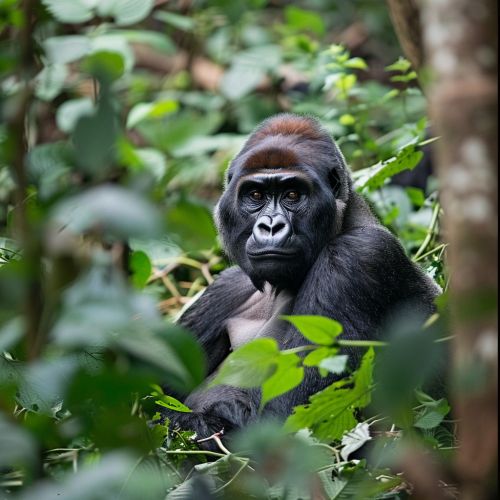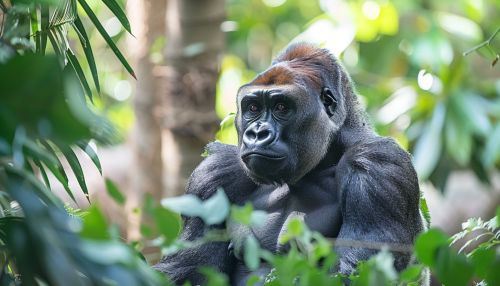Western lowland gorilla: Difference between revisions
(Created page with "== Overview == The Western lowland gorilla (''Gorilla gorilla gorilla'') is one of the two subspecies of the western gorilla (''Gorilla gorilla''). This primate is native to the dense and remote tropical forests of western and central Africa, including countries such as Cameroon, Central African Republic, the Democratic Republic of the Congo, Equatorial Guinea, Gabon, and Angola. The western lowland gorilla is the smallest of the four gorilla subspecies, yet it...") |
No edit summary |
||
| Line 15: | Line 15: | ||
Their physical characteristics include a robust build with a broad chest and shoulders, long arms, and a short, thick neck. Their faces are characterized by a pronounced brow ridge, wide nostrils, and large, expressive eyes. The western lowland gorilla's coat is primarily black or dark brown, with the silverbacks displaying the eponymous silver hair on their backs. | Their physical characteristics include a robust build with a broad chest and shoulders, long arms, and a short, thick neck. Their faces are characterized by a pronounced brow ridge, wide nostrils, and large, expressive eyes. The western lowland gorilla's coat is primarily black or dark brown, with the silverbacks displaying the eponymous silver hair on their backs. | ||
[[Image:Detail-91767.jpg|thumb|center|A western lowland gorilla sitting in a forested area, surrounded by lush greenery.|class=only_on_mobile]] | |||
[[Image:Detail-91768.jpg|thumb|center|A western lowland gorilla sitting in a forested area, surrounded by lush greenery.|class=only_on_desktop]] | |||
== Habitat and Distribution == | == Habitat and Distribution == | ||
Latest revision as of 18:01, 19 June 2024
Overview
The Western lowland gorilla (Gorilla gorilla gorilla) is one of the two subspecies of the western gorilla (Gorilla gorilla). This primate is native to the dense and remote tropical forests of western and central Africa, including countries such as Cameroon, Central African Republic, the Democratic Republic of the Congo, Equatorial Guinea, Gabon, and Angola. The western lowland gorilla is the smallest of the four gorilla subspecies, yet it remains a significant subject of study due to its complex social structures, behavior, and conservation status.
Taxonomy and Evolution
The western lowland gorilla belongs to the family Hominidae, which includes humans, chimpanzees, and orangutans. The genus Gorilla is divided into two species: the western gorilla (Gorilla gorilla) and the eastern gorilla (Gorilla beringei). The western gorilla is further divided into two subspecies: the western lowland gorilla (Gorilla gorilla gorilla) and the Cross River gorilla (Gorilla gorilla diehli).
The evolutionary history of the western lowland gorilla is marked by its divergence from a common ancestor shared with humans and chimpanzees approximately 7-8 million years ago. The western and eastern gorillas diverged around 1.2-3 million years ago, with the western lowland gorilla and the Cross River gorilla splitting more recently, about 17,800 years ago.
Physical Characteristics
Western lowland gorillas exhibit sexual dimorphism, with males being significantly larger than females. Adult males, known as silverbacks due to the distinctive silver hair on their backs, can weigh between 140 to 270 kilograms (310 to 600 pounds) and stand about 1.5 to 1.8 meters (5 to 6 feet) tall when upright. Females are smaller, typically weighing around 70 to 90 kilograms (150 to 200 pounds) and standing about 1.2 to 1.5 meters (4 to 5 feet) tall.
Their physical characteristics include a robust build with a broad chest and shoulders, long arms, and a short, thick neck. Their faces are characterized by a pronounced brow ridge, wide nostrils, and large, expressive eyes. The western lowland gorilla's coat is primarily black or dark brown, with the silverbacks displaying the eponymous silver hair on their backs.


Habitat and Distribution
Western lowland gorillas inhabit the dense, tropical rainforests and swamp forests of western and central Africa. Their range includes lowland forests, swamp forests, and secondary forests. These gorillas are highly adaptable and can live in a variety of forest types, from primary forests with tall, mature trees to secondary forests that have regrown after logging or other disturbances.
Their habitat is characterized by high humidity, dense vegetation, and a complex structure that provides ample food sources and shelter. The western lowland gorilla's range is fragmented due to human activities such as logging, agriculture, and infrastructure development, which pose significant threats to their habitat.
Diet and Foraging Behavior
Western lowland gorillas are primarily herbivorous, with their diet consisting of a wide variety of plant species. They consume leaves, stems, fruits, seeds, and bark. Fruits make up a significant portion of their diet, especially during the fruiting season when they are abundant. Gorillas are known to travel long distances in search of fruiting trees and can cover up to several kilometers in a day.
In addition to plant material, western lowland gorillas occasionally consume insects, such as ants and termites, which provide a source of protein. Their foraging behavior is influenced by the availability of food resources, and they exhibit a high degree of dietary flexibility to adapt to seasonal changes in food availability.
Social Structure and Behavior
Western lowland gorillas live in social groups known as troops or bands. These groups are typically led by a dominant silverback male, who is responsible for the protection and cohesion of the group. A typical troop consists of one silverback, several adult females, and their offspring. Some groups may also include subordinate males, known as blackbacks, who have not yet reached full maturity.
The social structure of western lowland gorillas is characterized by strong bonds between the silverback and the females, as well as between mothers and their offspring. Grooming, play, and vocal communication are important aspects of their social interactions. Gorillas use a variety of vocalizations, body postures, and facial expressions to communicate with each other.
Reproduction and Lifespan
Western lowland gorillas have a slow reproductive rate, with females giving birth to a single offspring approximately every four to six years. The gestation period is about 8.5 months. Newborn gorillas are highly dependent on their mothers for care and protection. They are carried by their mothers for the first few months of life and gradually become more independent as they grow older.
Infant gorillas are weaned at around three to four years of age, but they continue to stay close to their mothers for several more years. Females reach sexual maturity at around eight to nine years of age, while males mature later, at around 12 to 15 years. The lifespan of western lowland gorillas in the wild is estimated to be around 35 to 40 years, although they can live longer in captivity.
Conservation Status and Threats
The western lowland gorilla is classified as Critically Endangered by the International Union for Conservation of Nature (IUCN). The primary threats to their survival include habitat destruction, poaching, and disease. Deforestation for logging, agriculture, and infrastructure development has led to significant habitat loss and fragmentation, reducing the available range for these gorillas.
Poaching for bushmeat and the illegal wildlife trade poses a significant threat to western lowland gorillas. Despite legal protections, hunting continues in many areas due to weak enforcement and high demand for bushmeat. Additionally, diseases such as the Ebola virus have had devastating impacts on gorilla populations, causing significant declines in some areas.
Conservation efforts for western lowland gorillas include habitat protection, anti-poaching measures, and disease monitoring and control. Protected areas and national parks play a crucial role in safeguarding gorilla populations, and community-based conservation initiatives aim to involve local communities in the protection and sustainable management of gorilla habitats.
Research and Study
Western lowland gorillas have been the subject of extensive scientific research, contributing to our understanding of primate behavior, ecology, and evolution. Field studies have provided valuable insights into their social structure, foraging behavior, and reproductive strategies. Research on captive gorillas has also contributed to our knowledge of their cognitive abilities, health, and physiology.
One of the key areas of research is the study of gorilla communication. Western lowland gorillas use a complex system of vocalizations, gestures, and facial expressions to communicate with each other. Understanding these communication methods helps researchers gain insights into the social dynamics and cognitive abilities of gorillas.
Genetic studies have also played a significant role in gorilla research. By analyzing DNA samples from wild and captive gorillas, scientists have been able to study their genetic diversity, population structure, and evolutionary history. This information is crucial for developing effective conservation strategies and managing captive breeding programs.
Human-Gorilla Interaction
Human activities have a profound impact on western lowland gorillas and their habitats. Deforestation, hunting, and disease transmission are some of the direct consequences of human presence in gorilla habitats. However, humans also play a vital role in gorilla conservation through research, conservation efforts, and ecotourism.
Ecotourism, when managed sustainably, can provide significant benefits for gorilla conservation. It generates revenue that can be used for conservation initiatives and provides economic incentives for local communities to protect gorilla habitats. However, it is essential to ensure that ecotourism activities do not disturb or harm the gorillas and their environment.
